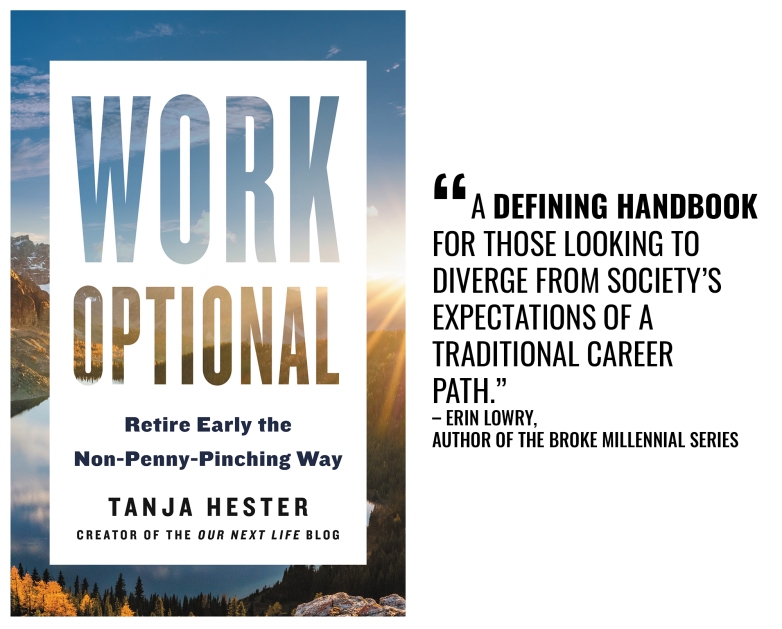Book Review – “Work Optional: Retire Early the Non-Penny-Pinching Way” by Tanja Hester

BLUF: “Work Optional: Retire Early the Non-Penny-Pinching Way” by Tanja Hester is an early retirement book that starts with the human elements of retirement, but also provides excellent methods for creating goals for retirement (including how to calculate the magic number of money you’ll need to fully retire).
This is the second book I’ve reviewed here, and also the second about the “Financial Independence” (a.k.a. early retirement) movement. I’ve found that due to the difficulty of retiring early that these “FI” books often reveal planning ideas that are not covered in traditional retirement books.
Though she provides a strong breakdown of technical retirement strategies, the main focus of the book is how to find the right balance between saving and spending that feels right, while also saving for your financial goals. This is a slight departure from other FI books that often ask readers to take the most spartan lifestyle approach to reach FI.
Let’s explore some of the highlights together.
——-
Throughout this book, Tanja covers a wide range of topics related to retirement. Though I won’t dig deeply into all the portions from the book, I’ll cover a few. To begin, here are her 10 rules to live by for a financially independent future:
- Envision the life you want before you assign numbers to it
- Invest early and often to create as much magic money (compound interest) as possible
- Create systems to help you succeed with minimum willpower required
- Constrain your spending by increasing your earnings to supercharge your savings faster than you will by pinching pennies
- Remember that everything compounds, investments earnings inflation everything
- Prioritize contentment over buying more stuff which rarely brings lasting happiness
- If you are in a couple include your partner in every stage of planning so it’s truly a mutual effort
- Always invest in your health
- Prioritize close social connections at every stage of life
- Strive to live a purpose filled life, not just a life without work
Envision the life you want:
Instead of starting with a technical analysis of saving and investing, her first step is to focus on what your day-to-day retired life would look like. This includes where you envision yourself living, the activities you will do, and who you will do them with. Instead of starting with a dollar amount, her recommendation is to start with this vision of the future in mind, and then determine how much you’ll need to live that life in the future.
Find your retirement goal (i.e your magic number):
Once you know how you want to live in retirement, deciding how much you need to afford that retirement is key. Your magic number (i.e. how much you need to invest to fully retire) is generally 25x to 35x your annual expenses. 25x means you will be living off of 4% of your investment each year, vs. about under 3% at 35x. Which is right for you depends on your risk tolerance, but the intent is to prevent you from running out of retirement money before you run out of life.
How to calculate your magic number:
- Find your annual spending, and then subtract any future pensions (i.e. military retirement)
- Multiply that number by 30
- Add additional known expenses (like kids’ college costs, etc.)
- Add +10% contingency
- The number you end up with is how much you’ll need to have invested to fully retire.
Using 30x allows for a more conservative approach to spending (3.3% vs 4% withdrawals) and also leaves room for increasing costs such as health care.
Limiting Spending:
With this calculation in mind, lowering your annual spending is extremely important. Because your magic number is more than 30x your annual spending, cutting your costs has a massive effect on your magic number. For example, reducing your home insurance payments by $100/month (or, $1,200/year) will lower the amount you need to save for retirement by over $36,000.
This also works for buying things in your daily life, including small expenses. Buying $5 cups of coffee will require you to save $150 for each one. This is because these small purchases become habits, and will be money you’ll likely spend in retirement as well. By cutting these types of expenses from your daily life, you can trim the amount you need to save… and ultimately, can retire earlier.
Invest early and often to create magic money:
To reach this goal, she suggests investing as early as possible to create “magic money” (i.e. money from passive income). To build wealth you don’t have to beat the market, you just have to match the market. And, investing early is always better than trying to time the market (which no one can do consistently). She recommends to ignore the short term fluctuations in the market, but instead continue to invest consistently.
To make it easy, she recommends using systems to pay your investments first. She uses automatic payments into her investment accounts each month (“to hide money from herself”), which allows her to continue investing without much thought. By continuing to invest this way, it prevents her from forgetting to invest each month and makes it easier to live without the money she is investing.
——————
There is a lot of good investing advice in this book, much of which I did not cover here. If you are interested in early retirement, or just looking for new ways to think about retirement investing, “Work Optional” will be an excellent read resource for you.
Like most books I read, it is also available via the DoD’s MWR library (on the Libby app) or can be bought on Amazon.